#arnoglossum
Photo
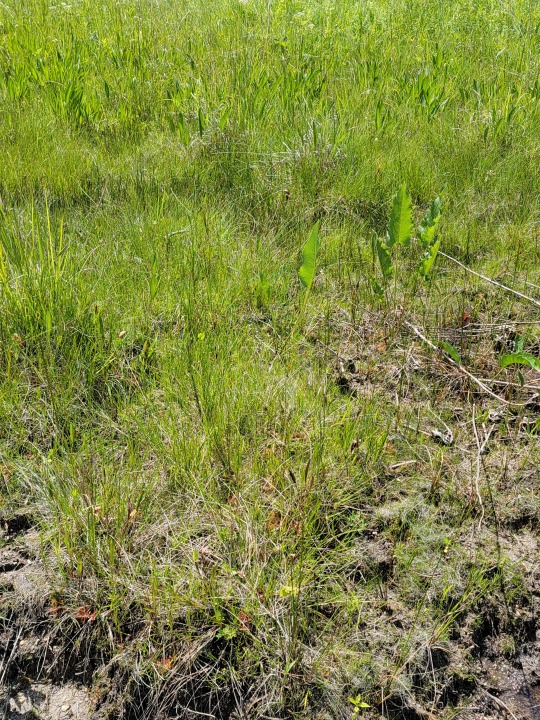
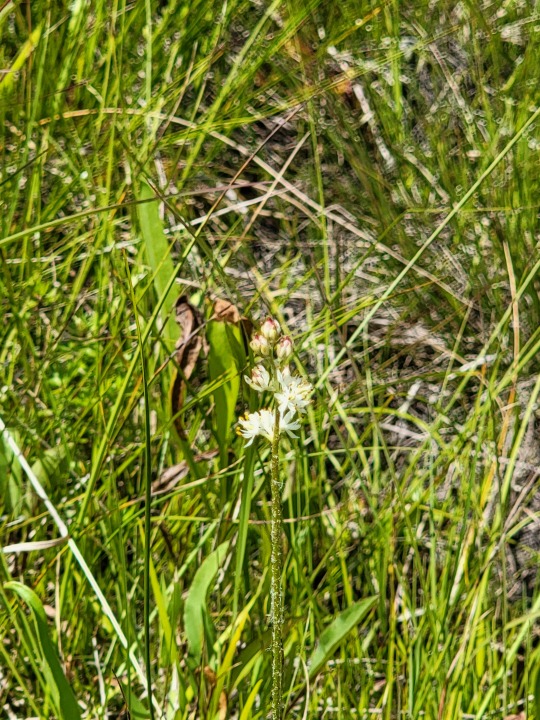




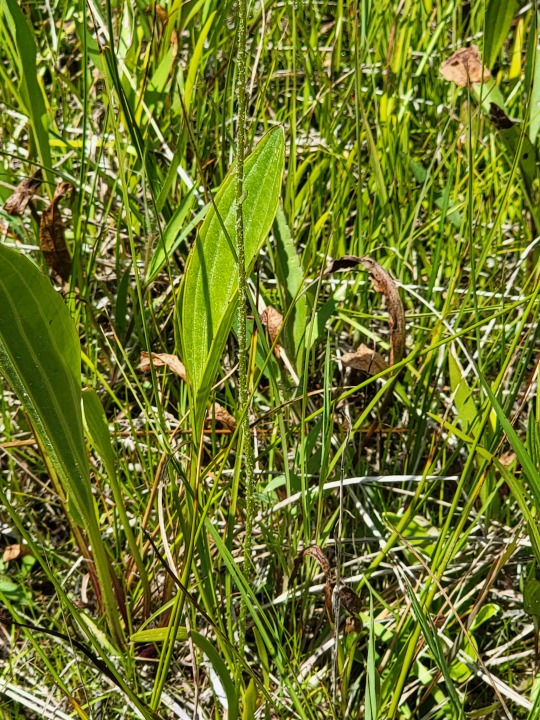
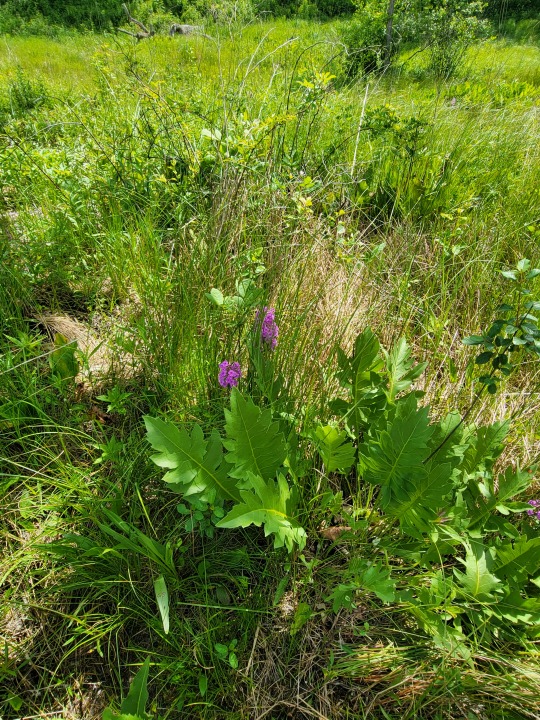


Denizens of the Marl,
My main focus was to introduce an early blooming species that I don’t know if I talked about ever. I usually miss my window to see this plant and for some reason I’ve never gotten close enough to photograph it properly, you can kinda see a gleam of light on the glandular hairs but not well enough to show structure.
Triantha glutinosa, blooms in early June in Ohio but can last till late June and in other states occurs in bogs in warm water conditions and blooms much later which is strange to me. I think this must be an adaptive phenotypical thing but you would expect it to be opposite and light blooming also seems to not be the culprit so I don’t know. False Asphodel is another common name but I honestly prefer calling it sticky or glutinous false ashpodel. As a plant living in these nutrient poor super leached marl flats this plant is a carnivor, protease excretor glandular hair trap specifically, but strangely only on it’s flowering stem and not on it’s minute basal rosette. Opposite of most species that are carnivores most species try to keep traps as far from the flowers as possible which makes sense evolutionary. Glandular traps near an inflorescence seems strange for successful pollination. As it turns out this may be a seldomly pollinated species where most individuals in populations are ancient clones that have formed from rhizome spread overtime in these glacial refugium. The other thing that seems notable is many people studying these false ashpodels (Triantha spp.) run into the same morphology and phenology problems that I have, and have even come to contempt and discourse over specific populations and are evaluating them as part of a biological species complex. I agree on the T. occidentalis western split on all accounts but some of the minor disjunct probable splits seem more complex overall (Central Appalachian mountain populations (TN, VA, SC, GA)
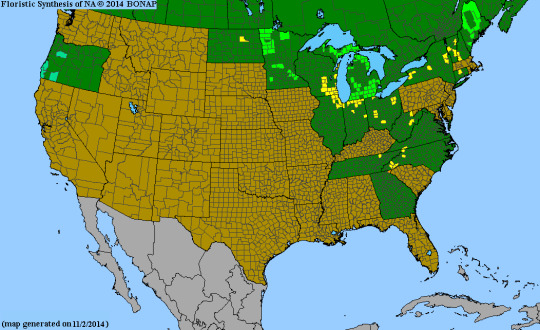
I feel like I can’t stress the importance of this limestone marl and the unique opportunity of getting this close to these plants without any special camera. Though I do wish I had one to display the features properly. Most of the time if you are traversing a fen you have to find and identify petrified marl shelfs or surface travertines, or you are walking on old and ancient tussock clumps from what is usually Carex stricta. Im walking on a displaced gravel shelf with petrified marl and wouldn’t dare to walk off of it and disturb the easily motile banks of loose marl or the suspended marl sediment floating like quick sand. The plants here are fragile and the habitat is equally fragile with many state listed species that cant take damage. Everywhere in the high exposure areas of marl flats are these Drosera rotundifolia and the smooth rounded/heartshaped leaves of grass of parnassas, which is in bloom as I type. Parnassia glauca is so beautiful with it’s unique floral venation and Ill post more pics once again when I get to it. The farther you get from the flats the less exposure and with it comes the sedge meadow with Arnoglossum plantagineum, also known as fen plantain leaved indian plantain. The last few shots are associated with the fully scabrid moderate sized var. ,not species, Silphium terebinthinaceum var. pinnatifidum, which we only see in fens in Ohio and the Ice scoured dwarf willow, Salix myricoides, in all of it’s new leaf glory. Still not looking blue with white pubescent undersides just yet.
Personal note:
Its been really weird doing this lagged posting because these are not matched to the time I was there. Right now, I feel like I should be posting about white bottle gentian, prairie gentian ,fringed gentian or ,andrews bottle gentian and here I am mid June posts. Heck it’s also Spiranthes spp. season and paw paw shaking season rn, most people are smelling sulfur shelves and foraging chicken of the woods(same thing). Trying to catch up and doing documentation and having a place to post personal thoughts on this stuff.
#fens#meadowcore#silphium#salix#salix myricoides#arnoglossum#arnoglossum plantagineum#species complex#carnivourousplant#carnivory#botany#ecology#wildflowers#ohio news#ohio#kawaii#plantblr#botanical#botany on tumblr#plants on tumblr#plants#drosera#drosera rotundifolia#geology#cottagecore#parnassia#parnassia glauca#triantha glutinosa#triantha
24 notes
·
View notes
Text

Indian Plantain (Arnoglossum) by Picsnapper1212
0 notes
Photo

Pale Indian plantain is lovely and not actually a plantain at all.
10 notes
·
View notes
Photo

Tuberous Indian Plantain (Arnoglossum plantagineum)
Schurch-Thomson Prairie, WI, 6-24-17
#tuberous indian plantain#arnoglossum plantagineum#flower#wildlflower#original photographers#photographers on tumblr#imiging#nature photography
6 notes
·
View notes
Photo




Wildflowers growing in a prairie on the South side of Houston, TX, USA:
Prairie Plantain, Arnoglossum plantagineum
Missouri Ironweed, Vernonia missurica
Prairie Blazingstar, Liatris pycnostachya
Arrowleaf Sida, Sida rhombifolia
Photographs by Paxon Kale
32 notes
·
View notes
Text
Poetry Group B
Guillermo Zapata
In Remembrance of The Heroes
We are gathered here today,
To commemorate those brave soldiers
Who gave their lives
In the war
Daniel H. Burnham, our proud general
Alfred Caldwell, head of artillery
Edward J. Kelly, colonel
And the many hundreds of men and women
Who lifted the stones,
heaved trash,
and trampled the ground.
But also, let us not forgot those poor souls,
Caught on the wrong side,
Who had their lives taken away,
So brutally by circumstance.
Podilymbus podiceps, the expert diver
Acris blanchardi who sang like the crickets
Carex garberi who fed the elk
And the 130 more displaced,
Or killed, by this disastrous event.
Let us bow our heads in a moment of silence.
The service will be followed with a reception in McCormick place,
Please join us for hor d'oeuvres: duck, frog legs, and wild greens.
A plaque of the dead is found hours later, buried in the grass and dirt. The reader brushes it off until the edges are found, it reads as it does below:
Will be included at end of notes.
Process notes below the cut:
Process Notes:
This is the beginning of my final work which is meant to be a historical and ecological study of the midway and it’s relationship to both humans and animals. We always seem to support the ideals of constant progress but often get there when the past has already been destroyed. I did research of every threatened wetland species in Illinois and the surrounding Wisconsin and Michigan area. Particular species are more likely to have existed here than others but all may have lived here in the Chicago area, and all no longer do. The species themselves may not be at risk but their presence in the aforementioned states is threatened for every single one. The piece I’ve written is intended to treat them as an afterthought in a satirical manner, mocking remembrance speeches of these sort that ignore the victims of those remembered. In the actual work there will be a plaque of the dead following this piece, the names of which I’ve inserted below along with the entirety of my notes and the websites that I used to gather the information.
Animals endangered that live in marshland in Illinois:
pied-billed grebe
northern harrier
http://wwx.inhs.illinois.edu/resources/inhsreports/jan-feb96/wetlands/
“More than half of the country's original wetland area has been lost, and over 200,000 more acres disappear each year. Illinois, in particular, has been devastated, losing more than 90% of its original wetland acres.”
Michigan: https://mnfi.anr.msu.edu/communities/community.cfm?id=10671
“Water-level control has altered natural wetland dynamics. All the connecting channels have been modified to accommodate shipping, resulting in increased shoreline erosion. Agricultural drainage has eliminated large areas of marshes, and agricultural sedimentation has greatly increased turbidity, eliminating submergent species that require clear water. The resulting deposition of rich organic sediments in the wet meadow zone and along the shoreline favors early-successional species. Nutrient loading has locally reduced oxygen levels, prompted algal blooms, and led to the dominance of high-nutrient tolerant species such as cat-tails.
Urban development degrades and eliminates coastal marshes through pollution, land management, and ecosystem alteration. Armoring shoreline and dredging of harbors eliminate marshes. Dumping of waste materials such as sawdust, sewage, and chemicals alters shallow-water marsh environments, increasing turbidity, reducing oxygen levels, and altering the pH. Shipping traffic erodes shoreline vegetation through excessive wave action. Introductions of invasive plants and animals have altered community structure and species composition. Many invasive species arrive in shipping ballast, while others are purposefully introduced.”
City planning: http://www.encyclopedia.chicagohistory.org/pages/10537.html
Daniel H. Burnham
http://www.chicagoparkdistrict.com/parks/Burnham-Park/
Alfred Caldwell (designed the point)
Mayor Edward J. Kelly
Racine http://dnr.wi.gov/topic/NHI/Data.asp?tool=county&mode=detail&county=52
Kenosha http://dnr.wi.gov/topic/NHI/Data.asp?tool=county&mode=detail&county=30
The Plaque of the Dead:
Here are the names of those who perished but were not forgotten. Those who were forgotten can never be found.
Acipenser fulvescens
Acris blanchardi
Adlumia fungosa
Aflexia rubranura
Agalinis auriculata
Agalinis skinneriana
Agrimonia parviflora
Alasmidonta marginata
Alasmidonta viridis
Alosa chrysochloris
Ammodramus henslowii
Aplectrum hyemale
Arnoglossum plantagineum
Asclepias lanuginosa
Asclepias purpurascens
Asclepias sullivantii
Astragalus neglectus
Bartramia longicauda
Besseya bullii
Bird Rookery
Bog relict
Bombus affinis
Botaurus lentiginosus
Botaurus lentiginosus
Botrychium campestre
Buteo lineatus
Cakile edentula var. lacustris
Cakile edentula var. lacustris
Calamovilfa longifolia var. magna
Calcareous fen
Carex garberi
Carex lupuliformis
Carex swanii
Charadrius melodus
Chlidonias niger
Chlidonias niger
Circus cyaneus
Cirsium hillii
Cistothorus palustris
Clinopodium arkansanum
Cuscuta glomerata
Cuscuta polygonorum
Cypripedium candidum
Destria crocea
Dichanthelium wilcoxianum
Dry-mesic prairie
Echinacea pallida
Elaphe vulpina gloydi
Eleocharis compressa var. compressa
Eleocharis rostellata
Elymus lanceolatus ssp. psammophilus
Emergent marsh
Emydoidea blandingii
Emydoidea blandingii
Enallagma basidens
Ephemeral pond
Epilobium strictum
Erigenia bulbosa
Erimyzon sucetta
Etheostoma microperca
Euphorbia polygonifolia
Eurybia furcata
Falco columbarius,
Falco peregrinus
Fimbristylis puberula
Floodplain forest
Fundulus dispar
Great lakes dune
Hydrastis canadensis
Ixobrychus exilis
Ixobrychus exilis
Jeffersonia diphylla
Juncus marginatus
Lake--deep, hard, drainage
Lake--shallow, hard, seepage
Lake--soft bog
Lepomis megalotis
Lespedeza leptostachya
Luxilus chrysocephalus
Lythrurus umbratilis
Mesic prairie
Migratory Bird Concentration Site
Moxostoma carinatum
Muhlenbergia richardsonis
Myndus ovatus
Northern wet forest
Notropis anogenus
Nycticorax nycticorax
Nycticorax nycticorax
Papaipema beeriana
Papaipema silphii
Penstemon hirsutus
Phegopteris hexagonoptera
Phlox glaberrima ssp. interior
Plantago cordata
Platanthera hookeri
Platanthera leucophaea
Polygala incarnata
Polystichum acrostichoides
Prenanthes aspera
Prenanthes crepidinea
Procambarus gracilis
Ptelea trifoliata ssp. trifoliata var. trifoliata
Rallis elegans
Rallus elegans
Ranunculus cymbalaria
Regina septemvittata
Riverine Lake/Pond
Scleria triglomerata
Scleria verticillata
Scutellaria ovata ssp. ovata
Shrub-carr
Sistrurus catenatus
Solidago caesia
Somatochlora hineana
Southern dry forest
Southern dry-mesic forest
Southern hardwood swamp
Southern mesic forest
Southern sedge meadow
Southern Tamarack Swamp
Spermophilus franklinii
Springs and spring runs, hard
Sterna forsteri
Sterna forsteri
Stream--fast, hard, warm
Sturnella neglecta
Thalictrum revolutum
Thamnophis proximus
Thamnophis sauritus
Triantha glutinosa
Trichophorum cespitosum
Triglochin palustris
Utricularia resupinata
Venustaconcha ellipsiformis
Viburnum prunifolium
Villosa iris
Wet prairie
Wet-mesic prairie
Xanthocephalus xanthocephalus
0 notes
Photo






Arnoglossum plantagineum
Fen Indian Plantain
Even when it’s not open it’s impressively showy, a classic fen species along marl tufts and tussock mounds in any marl flat or sedge meadow. always elevated out of the direct water in open sunlight.
Photographed at Cedar Bog(a fen)
Within’ this genera there are some amazing members, each are showy in comparison to other species where they are found, and each are beetle and wasp magnets. This species boasts some classic looking monocot affiliated leaves but it is actually not at all related to monocots and is actually in a eudicot family Asteraceae in the tribe Senecioneae. which many people find to be interesting since it’s inflorecence is an umbelled capitulacence with capitulum lacking traditional involucre bracts or daisy ray(aka ligule flowers or attractive bractoid petaloid flowers) infact, it almost doesn’t look like it’s capitulum( asteraceae flower(inflorescence) head that is a characteristic outgroup factor or synapomorphy for the families’ floral morphology) hold more that a single floret( functional tube flower) at first glance and can even appear single flowered until a transient moment at full anthesis( peak phenological bloom)
#wildflowers#botany#ohio#arnoglossum#morphology#asteraceae#arnoglossum plantagineum#meadowcore#prairie#prairiecore#flowercore#cottagecore
9 notes
·
View notes
Photo






Arnoglossum plantagineum, a shorter stout species when compared to other “indian plantains” Arnoglossum spp. and another fen classic, a forbe member asteraceae that has minimalistic, nondiscript phyllaries and encapsulating ligules(daisy rays) fused to it’s phyllaries, so much so that these ligules are never exposed. The fused phyllaries form a ridged tube which eventually opens up and exposes a small number of florets with cream colored carolla in full anthesis. (these photos are prior to that). Fen communities like this were once more open but have started closing up due to the removal of regular fires(fire supression). The leaves of fen indian plantain are mostly basal and spoon like with parallel veination, cauline leaves are few and progress to smaller size approaching the apex. These leaves are toothed, and pretty interesting upclose. Imbricated species are mostly sedges(Carex spp.) and Spiranthes spp. with a dotting of krumholtz old growth Dasiphora fruticosa (Byosyn :Potentilla fruticosa) just finishing up blooming. (pictured at the bottom with leaves) growing on tavertine ridges wedged into the seaps.
34 notes
·
View notes
Photo





Arnoglossum atriplicifolium
I can’t get enough of these alkaline loving species, pale indian plantain is a show stopper and has one of the more simplest capitulum (rather simplified in morphological units) for asteraceae, I would definitely recommend looking at the condensed florets and anthers with a hand lense if you have time one day. The stigmas are simple too, but have two clear carpel separations with ligule(tongue like/ not to be confused with daisy rays) like lobes at the apex which are somewhat visible in some detail in the middle shot.
While this species is considered a fen and prairie species, it’s not uncommon to see them along road side cuts and in ravine systems or in savanna.
7 notes
·
View notes
Photo


Toxicodendron vernix,
poison sumac, bog rash plant, and even just toxic tree.
This species is gorgeous and has some of the most intense anacardiaceae red foliage come fall, for now it’s red stems and a slight white waxy sheen, or vernix; from what i’ve picked up means somewhat white epicuticular wax along the new growth associated often with fowl taste or antimicrobial wax, in this case it’s still a deterrent as this epicuticular wax is known for having large amounts of urushiol which causes contact dermatitis. In many cases, epicuticular wax being produced is either a white farina or a glaucous(tinged blue) more stable deterrent of ultraviolet light.
I actually plan on posting more pictures of this species tonight to show floral morphology and size as well as variation in habitat, but I really liked this image set separate because it had an eerie feeling to it with the dark dense swampland in the back ground and the Arnoglossum plantagineum look like little spirits. Giving this plant some nice scary vibes to go with the name.
34 notes
·
View notes
Photo

A patch of summer bliss.
Adena Mound Prairie, Silphium integrifolium, Monarda fistulosa, and Ratibida pinnata are visibly showy.
.
Diverse communities like this take thousands of years to form, soil microbes and mycological diversity is incredibly important for health of these ecosystems and this is why it takes so much time for core and rare species to get established. Prairie mycorrhizal connections and decomposition specific fungus are not widely understood nor are they studied to the extent that some species are. Silene regia, Lilium philidelphicum, Amorpha canescens, every member of Orchidaceae, and Arnoglossum spp. are associated with decent access to beneficial fungus being available for symbiotic connections in soil. Lilium spp. form protocorm prior to true germination and during that time period they either require open sunlight with warm moist soil or function from fungal symbiotes that allow sharing of carbohydrates, similarly this occurs with Orchids too. Orchids form protocorm only if symbiotic fungi are ambient in the soil. Orchid seeds, for the vast majority of all of the species out there, lack endosperm and can not germinate readily. Endosperm associated with feeding developing embryo for plants.
Amorpha canescens also requires aerated soil; in many prairies this occurs from aggregate soils from microbe and fungal activity, not just sand prairie or rocky prairies can have this species. The other limiting factors are ambient Rhizobium or other Nitrogen fixing microbes. Rhizobia–legume symbiosis is a known and critical concept for life for this species among other members of Fabaceae(but not all of them).
Want to read more:
http://floraofohio.blogspot.com/2014/08/
https://www.ncbi.nlm.nih.gov/pmc/articles/PMC4874859/
https://www.researchgate.net/publication/227675879_Demographic_viability_of_populations_of_Silene_regia_in_midwestern_prairies_Relationships_with_fire_management_genetic_variation_geographic_location_population_size_and_isolation
https://link.springer.com/book/10.1007%2F978-1-4419-7427-3
https://www.fs.fed.us/ne/newtown_square/publications/technical_reports/pdfs/scanned/gtr66.pdf
https://www.fs.fed.us/database/feis/plants/shrub/amocan/all.html
https://www.nature.com/articles/srep18031
https://www.nature.com/articles/s41396-020-0648-9
#reference guide#reference#botany#ohio#wildflowers#plantblr#cottagecore#meadowcore#kawaii#silphium#silphium integrifolium#monarda fistulosa#monarda#ratibida pinnata#ratibida
72 notes
·
View notes
Photo

Tuberous Indian Plantain (Arnoglossum plantagineum)
Schurch-Thomson Prairie, WI, 6-18-17
#tuberous indian plantain#arnoglassum plantagineum#flower#wildflower#original photography#photographers on tumblr#imiging#nature photography
90 notes
·
View notes
Photo





Wildflowers on the prairie, Houston, TX, USA:
Slender Blazingstar (Liatris acidota)
Texas Vervain (Verbena halei)
Aquatic Milkweed (Asclepias perennis)
Indian Plaintain (Arnoglossum ovatum)
photographs by Paxon Kale
20 notes
·
View notes